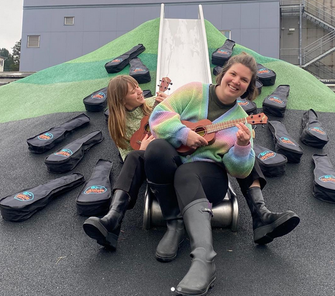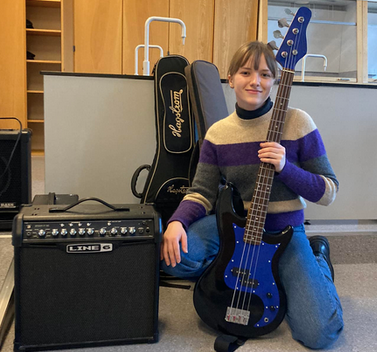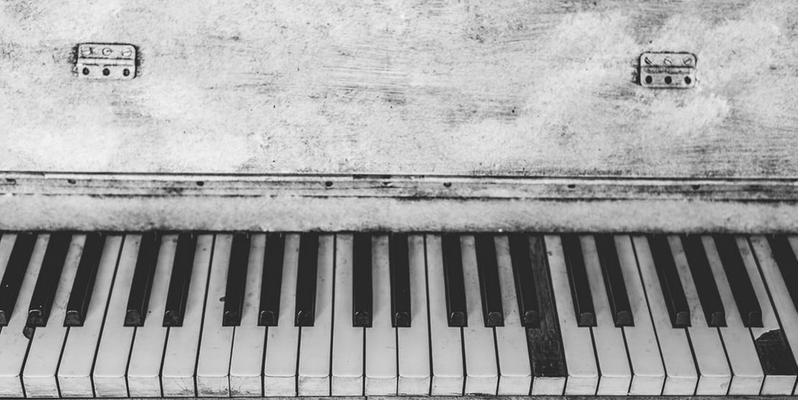Welcome to Music Therapy!
Summer update:
Zane and Suzanne will continue music therapy up until summer vacation.
😎
Music therapist Johannes Medlien will take over music therapy through 2023!
Thanks a lot to Bergen Live for this wonderful opportunity, and for inviting all the youth to Bergenfest UNG 13th June.
😎
Feel free to check out this article about our project in the ukulele magazine Ukelandia.
😎
Wishing all student, parents, teachers and collaborators a super duper summer!
We are music therapist Suzanne Helmons (LUCA Muziek, Belgium) and music therapy students Julie Liisberg and Zane Danosa (Grieg Academy, Norway),who have just begun this project, supervised by associated professor Viggo Krüger.
Here we will write about music therapy, especially in a context with refugee children. We will not mention people involved or specific cases, but rather post general info about music therapy methodology, literature, theoretical perspectives, cultural implications, and our own reflections from musicking with this diverse group.
We hope this website can be helpful and nice for those involved, as well as anyone interested in music therapy.
Feel free to contact us with questions or ideas!
Suzanne: su.helmons@live.be
Julie: julie.liisberg@student.uib.no
Ми — музичний терапевт Сюзанна Хелмонс (LUCA Muziek, Бельгія) і студенти музичної терапії Джулі Лійсберг і Зейн Даноса (Академія Ґріга, Норвегія), які щойно розпочали цей проект під керівництвом доцента Вігго Крюгера.
Тут ми напишемо про музичну терапію, особливо в контексті дітей-біженців. Ми не будемо згадувати залучених людей чи конкретні випадки, а радше опублікуємо загальну інформацію про методологію музичної терапії, літературу, теоретичні перспективи, культурні наслідки та наші власні роздуми про музикування з цією різноманітною групою. Оновлення публікуватимуться приблизно щотижня.
Ми сподіваємося, що цей веб-сайт може бути корисним і приємним для тих, хто залучений, а також для всіх, хто цікавиться музичною терапією.
Не соромтеся звертатися до нас із запитаннями чи ідеями!Сюзанна:
su.helmons@live.beДжулі:
julie.liisberg@student.uib.no
Suzanne (left) and Julie (right).
Ukuleles donated by Ukulele Kids Club
What is music therapy?
- Bruschia (1998): "a systematic process of intervention wherein the therapist helps the client to promote health, using musical experiences and the relationships that develop through them as dynamic forces of change"
- WFMT, Word Federation of Music Therapy (1996): “Music therapy is the use of musical elements (sound, rhythm, melody and harmony) by a music therapist with a client or group, in a process designed to facilitate and promote communication, relationships, learning, mobilisation, expression, organisation and other relevant therapeutic goals, to meet physical, emotional, mental, social and cognitive needs. Music therapy is aimed at developing the individual's abilities and/or restoring functions so that the person can achieve a better quality of life.”
- Suzanne: Using music as a way to create interaction, create a safe space where the children can express themselves.
- Julie: Using music in an active, research based, goal-oriented way to support people's needs regarding health, wellbeing and social issues.
Що таке музична терапія?
- Bruschia (1998): «систематичний процес втручання, під час якого терапевт допомагає клієнту зміцнити здоров’я, використовуючи музичний досвід і стосунки, які розвиваються через нього, як динамічні сили змін»
- WFMT, Word Federation of Music Therapy (1996): «Музична терапія — це використання музичних елементів (звуку, ритму, мелодії та гармонії) музичним терапевтом з клієнтом або групою в процесі, призначеному для полегшення та сприяння спілкуванню, стосункам. , навчання, мобілізація, вираження, організація та інші відповідні терапевтичні цілі для задоволення фізичних, емоційних, розумових, соціальних і когнітивних потреб. Музична терапія спрямована на розвиток здібностей людини та/або відновлення функцій, щоб людина могла досягти кращої якості життя».
- Сюзанна: Використовуючи музику як засіб взаємодії, створіть безпечний простір, де діти можуть висловлюватися.
- Джулі: Використовуйте музику в активний, дослідницький і цілеспрямований спосіб для задоволення потреб людей щодо здоров’я, благополуччя та соціальних питань.
- Zane:
Our theoretical framework
- Trauma informed care
- Community music therapy
- Music centered music therapy
- COVER model: COntext-sensitive classification model for music therapeutic interVEntions withRefugees
Наша теоретична основа
- Інформована допомога при травмах
- Громадська музична терапія
-
Музикотерапія, орієнтована на музику
- Модель COVER: Контекстно-залежна модель класифікації для музично-терапевтичного втручання з біженцями
Why music therapy with refugees?
- Providing people with the means to emotionally express feelings such as homesickness, loneliness, despair, and so on;
- Preserving and developing people's cultural identity and orientation according to the culture of their native country. Listening to and playing the music of their own country stimulates the perception of their culture. Especially in a process of adaptation to the new culture, it is important for them to keep in touch with their own culture.
- Provide musical structure as safe boundaries within which a client can express himself;
- Encouraging social interaction; having positive experiences and enjoying them together.
- Develop positive aspects of current psychological functioning, including ego-building activities aimed at stimulating initiative, encouraging people to use their own talents, helping people to influence their own (musical) environment…
- (Orth, 2005)
Чому музикотерапія з біженцями?
Надання людям засобів для емоційного вираження таких почуттів, як туга за домом, самотність, відчай тощо;Збереження та розвиток культурної самобутності та орієнтації людей на культуру рідної країни. Слухання та відтворення музики своєї країни стимулює сприйняття їхньої культури. Особливо в процесі адаптації до нової культури для них важливо підтримувати зв’язок зі своєю культурою.Забезпечте музичну структуру як безпечні межі, в межах яких клієнт може виразити себе;Заохочення соціальної взаємодії; отримати позитивні враження та насолоджуватися ними разом.Розвивайте позитивні аспекти поточного психологічного функціонування, включаючи діяльність з формування его, спрямовану на стимулювання ініціативи, заохочення людей використовувати власні таланти, допомагаючи людям впливати на власне (музичне) оточення…(Орт, 2005)
Literature (Література / посилання)
- Baker, F., & Jones, C. (2006). The effect of music therapy services on classroom behaviours of newly arrived refugee students in Australia—a pilot study. Emotional and Behavioural Difficulties, 11(4), 249-260.
- Enge, K. E. A., & Stige, B. (2022). Musical pathways to the peer community: A collective case study of refugee children’s use of music therapy. Nordic journal of music therapy, 31(1), 7-24.
- Enge, K. E. A. (2015). Community music therapy with asylum-seeking and refugee children in Norway. Journal of Applied Arts & Health, 6(2), 205-215.
- Hunt, M. (2005, July). Action research and music therapy: Group music therapy with young refugees in a school community. In Voices: A world forum for music therapy (Vol. 5, No. 2).
- Mallon, T., & Hoog Antink, M. (2021). The Sound of Lost Homes – Introducing the COVER Model – Theoretical Framework and Practical Insight into Music Therapy With Refugees and Asylum Seekers. Voices: A World Forum for Music Therapy, 21(2). https://doi.org/10.15845/voices.v21i2.3124
- Orth, J., Doorschodt, L., Verburgt, J., & Drožd, B. (2004). Sounds of trauma: An introduction to methodology in music therapy with traumatized refugees in clinical and outpatient settings. In Broken Spirits (pp. 473-512). Routledge.



